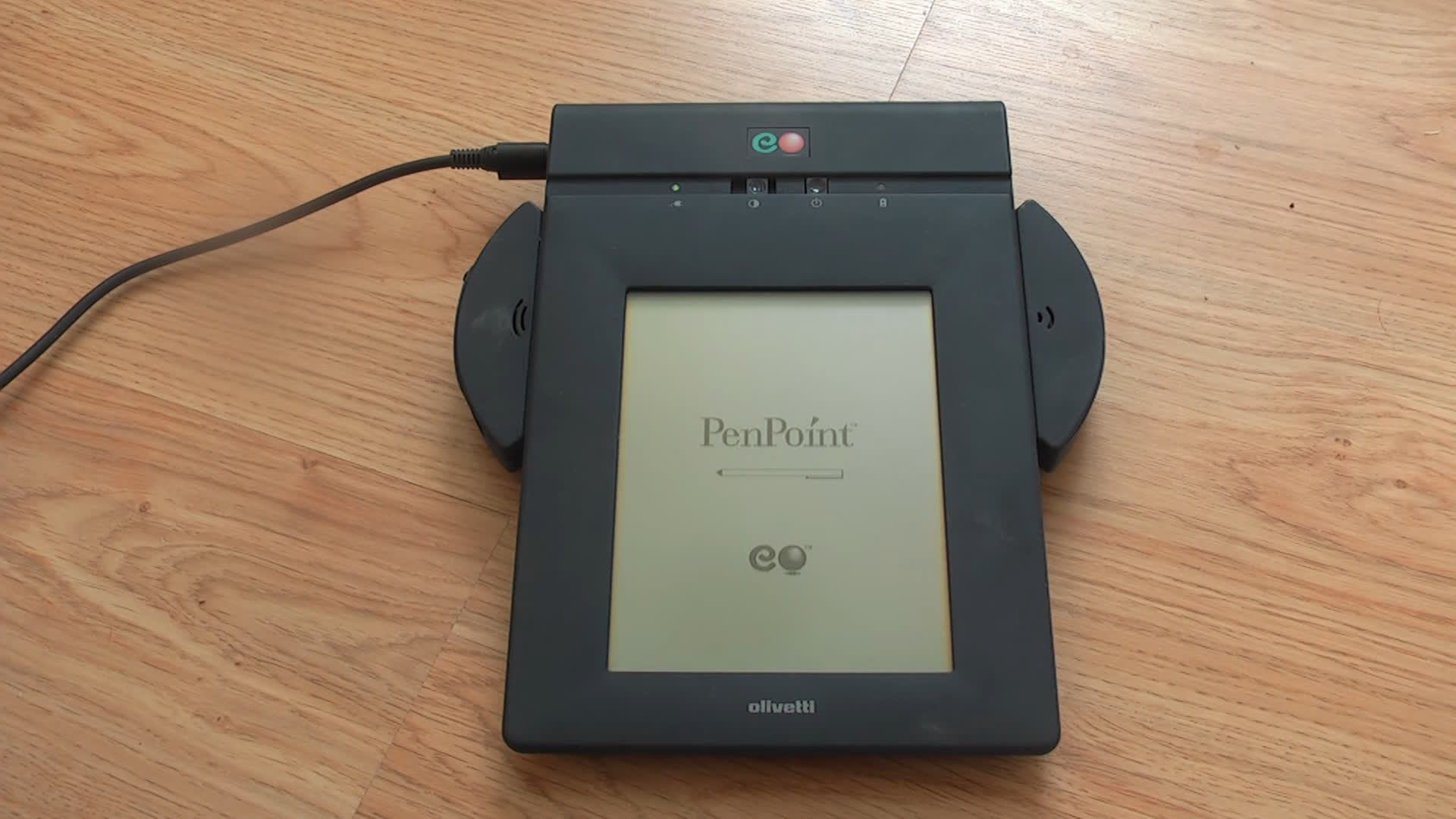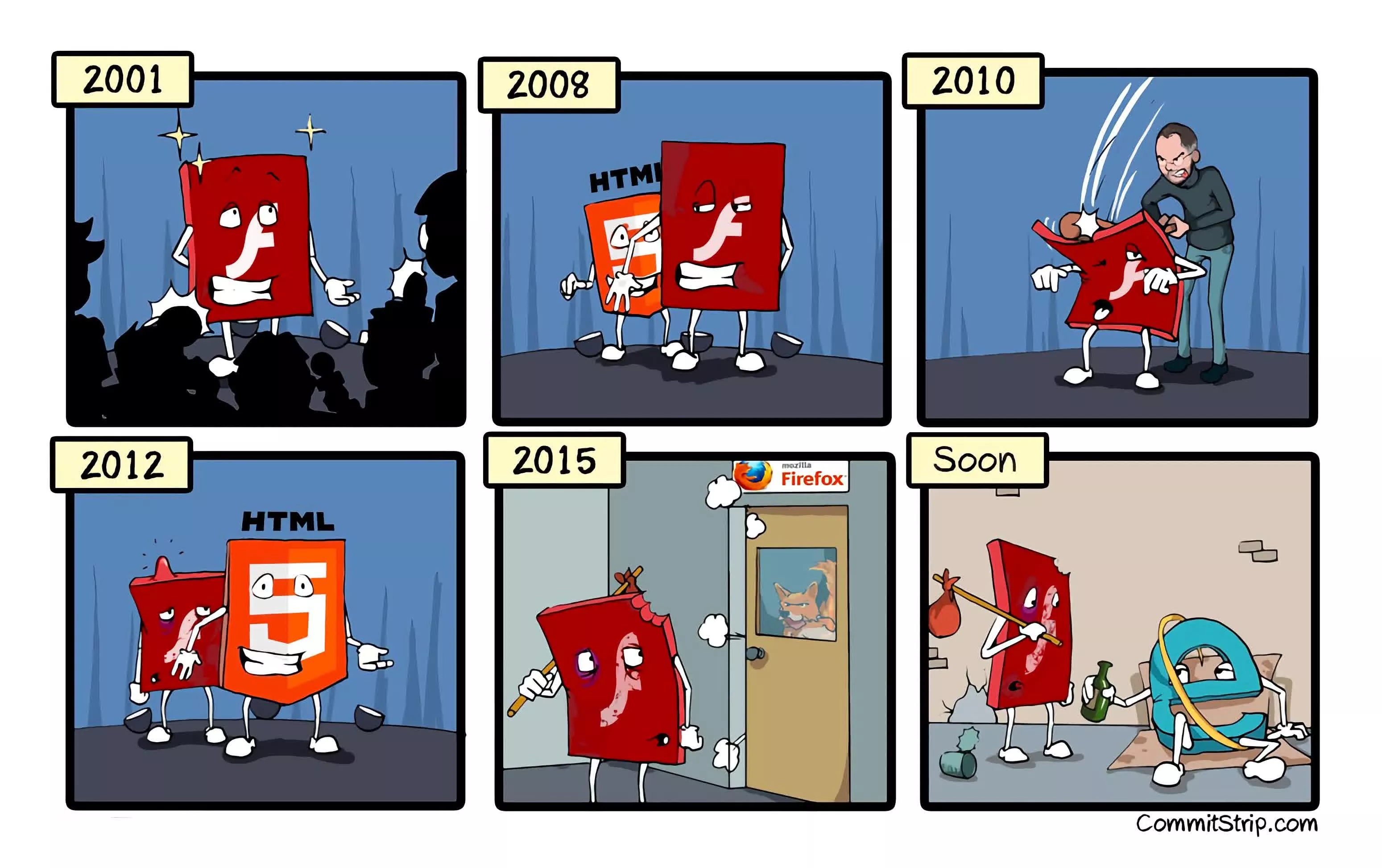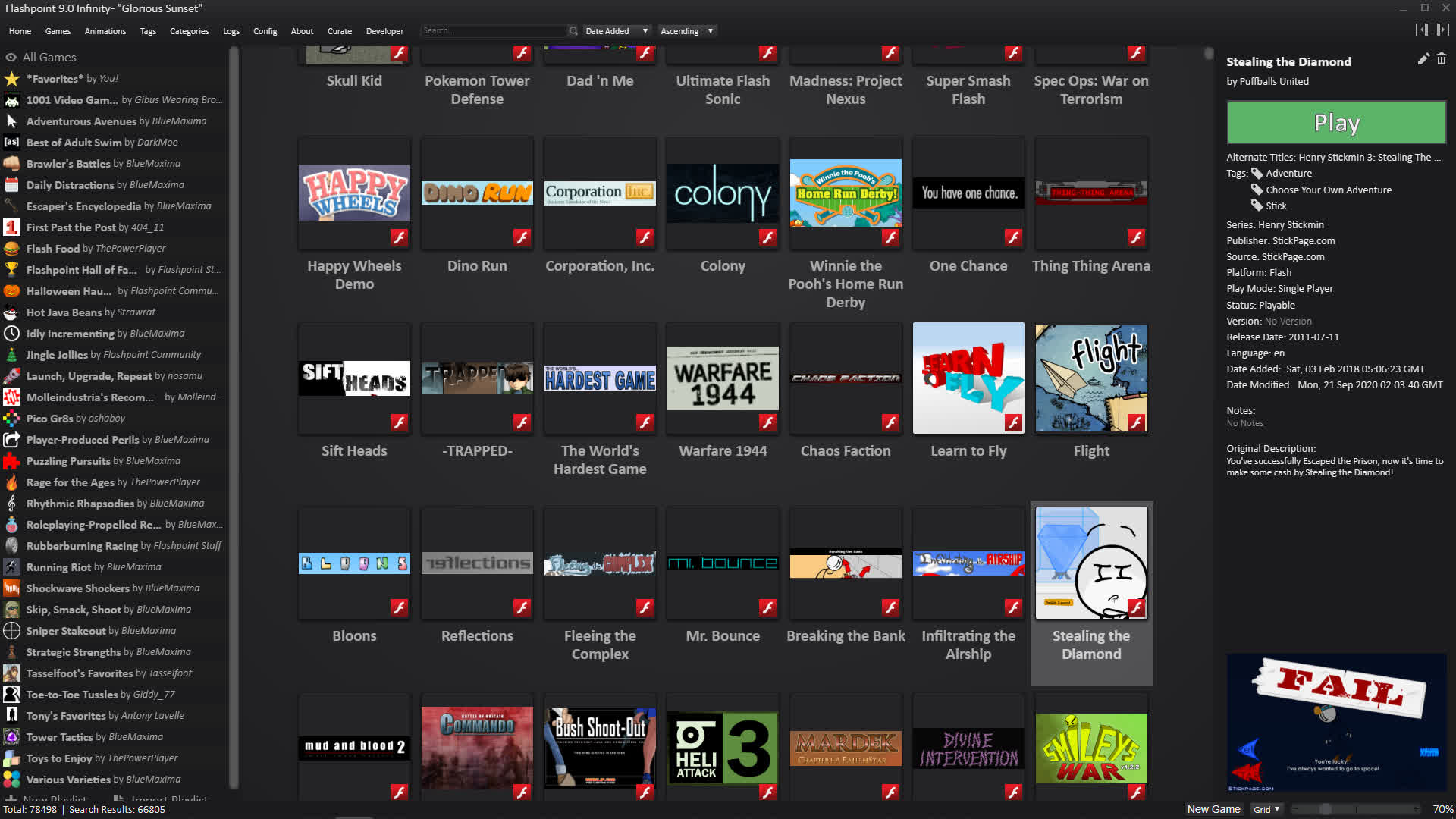What Ever Happened to Adobe Flash?
For many years, Adobe Flash was synonymous with animation on the web, browser games, and interactive websites. In 2011, the Flash Player plug-in was installed on 99% of desktop browsers in the Western world. One decade later, no modern web browser supports Flash outside of China.
In the 1990s, the internet was growing rapidly, and web browsers could not keep up with the pace of new file types that were designed to be shared over it. That led to the development of plug-ins: small apps that weren't designed to work independently, but add functions to the browser, like browser extensions do today.
Video plug-ins such as Apple QuickTime and the Windows Media Player showed video content that was made of individual frames, somewhat similar to how animated GIFs work, but with the added capability of showing some of those frames while the rest were downloading, and adding compression to improve loading speed at the expense of quality.
In the era of dial-up modems, internet video was either of low resolution, despairingly slow to load, or both. In that kind of context, interactive videos that loaded quickly and fully utilized the resolution of every screen looked like a miracle. This is the story of how a big part of the early web culture was formed.
Drawing a Future
In 1993, a company called FutureWave was founded by Charlie Jackson, Jonathan Gay and Michelle Welsh, releasing the SmartSketch drawing app for the PenPoint OS, which was one of the first operating systems for graphical tablets. SmartSketch created files based on vector graphics, similar to the modern SVG image format. In small tablets, it was important to be able to create images that would look the same when viewed on larger and higher-resolution screens.
When PenPoint flopped, the app was ported to Mac and Windows. In 1995, FutureWave added animation capabilities to the app and released it as FutureSplash Animator. In an early ironic move, Adobe declined an offer to buy FutureWave that year.

The FutureSplash Player plug-in released in 1996 was a strong alternative to Macromedia's Shockwave Player, which had become available the year prior and was capable of playing heavier file types that were also used in CD-ROM games. As impressive as it was, the scalable nature of FutureSplash videos wasn't the reason that they were seeing success. Rather, it was the ability to create surprisingly small files with the use of limited animation.
For showing an object moving on a static background, a FutureSplash file wouldn't need to include tens or hundreds of frames with the object in different places – it only needed to include instructions to move the object. Within hundreds of kilobytes, FutureSplash could create videos that were several minutes long.
Later that year, Microsoft used FutureSplash in the menu of MSN Program Viewer, a video streaming service that was years ahead of its time and failed quickly, making Microsoft completely abandon the concept. FutureSplash was later used in websites that were more successful at the time, including Disney Online and The Simpsons.
Interactive and Popular
Near the end of 1996, Macromedia acquired FutureWave, shortened the name FutureSplash to Flash, and re-released the FutureSplash Animator as Macromedia Flash.
The following year, Flash was used to create what's considered to be the first web-exclusive cartoon series: The Goddamn George Liquor Program, created by John Kricfalusi, known for The Ren & Stimpy Show. While more detailed than most Flash videos, it was still surprisingly watchable on the internet. In 1999, Showtime's WhirlGirl became the first series to be released simultaneously on a cable network and on the internet.
Adult-minded web cartoons such as Happy Tree Friends and Queer Duck later became TV shows. Flash-based series that were broadcast on TV from the start include The Powerpuff Girls, My Little Pony: Friendship Is Magic, and Foster's Home for Imaginary Friends.
In the Macromedia era, Flash was getting more and more interactive. One popular example of that was "Frog in a Blender," released by Joe Cartoon in 1999, which was one of the first viral videos on the internet. The user was able to go back and forth between the blender's first and ninth speed levels, but switching to the 10th level would quickly end the video (in Joe's defense, it was a very disrespectful frog).
A more impressive example of the same year was Pico's School, a point-and-click action-adventure game inspired by the Columbine High School massacre, developed by Tom Fulp and released on Newgrounds. The game turned Flash into a popular gaming platform, and Newgrounds into a central browser gaming hub.
Macromedia Flash 5, released in 2000, was the first to officially support ActionScript, a programming language that enabled the creation of much more sophisticated games. Over the years, games like Alien Hominid, Farmville, Club Penguin and the Meat Boy series started out using Flash.
Starting 2003, many mobile phones shipped with the Flash Lite app, which allowed them to play Flash content that was created with mobile platforms in mind.
In 2005, YouTube was launched, requiring the Flash Player to watch videos, even though the videos on the site weren't scalable or interactive in themselves. That year, the plug-in was installed on more than 98% of PCs connected to the internet. By the end of that year, Macromedia had been acquired by Adobe.
Bitten by an Apple

The first version of Adobe Flash was released in 2007 with improved Photoshop integration, and drawing tools that were similar to those offered by Adobe Illustrator. That same year, the first iPhone was launched with no Flash support. Despite being a fully fledged web browser (for a mobile device of that era), Safari did not support Flash websites which were very common then. The iPhone could play YouTube videos within the dedicated app, thanks to Google converting videos to the H.264 format following the iPhone's announcement.
The following year, HTML5 was released to the public, and was able to mimic Flash in sites coded using it without any plug-ins. That was achieved with the integration of JavaScript, which enabled interactivity similar to ActionScript; and later with CSS3, which was used to display HTML pages in several different ways, and supported adding SVG animations. One criticism of Flash was that as a plug-in, it could create cookies that the browser couldn't detect or remove.

Later in 2008, Adobe released its Integrated Systems development app, later called Adobe AIR, which enabled Flash content, such as games, to run within dedicated apps, removing the need for Flash Lite.
It took Adobe several years to create a fully functional mobile version of the Flash Player, and Steve Jobs wasn't willing to wait. In 2010, following the first iPad's announcement, the CEO famously published the Thoughts on Flash open letter, saying that Apple's mobile devices would never support the plug-in, citing performance, security and battery-life issues.
Jobs added that interactive Flash elements would need to be rewritten anyway for mobile sites to compensate for the lack of a mouse. His claim that Flash was a "closed system" was criticized as hypocritical, as the same could be said about iOS.
About two months after the letter, YouTube switched to HTML5-based playback on mobile platforms. At first, Apple didn't allow the development of Flash-based apps for iOS, but reversed that decision later. The Flash Player did come to Android devices eventually, but the disappointing performance shed a more positive light on Jobs' letter. In late 2011, Adobe halted the development of Flash Player for mobile devices.
On the desktop, Flash remained strong for several more years. By 2011 the Flash Player could utilize the GPU for 3D rendering using the Stage3D API, which launched a wave of 3D browser games and commercial demonstrations. JavaScript's answer to Stage3D was WebGL.
In 2015, YouTube switched to an HTML5-based player by default on all devices. The next year, Adobe Flash was renamed Adobe Animate to disassociate it from the ill-fated Flash Player.
In 2017, Adobe announced that it would stop supporting Flash by the end of 2020.
The Aftermath

Following Adobe's announcement, all modern web browsers started blocking Flash content by default, with the block becoming entirely effective after 2020. The last versions of Flash Player itself actually had a kill switch, which prevented them from running after January 12, 2021. Moreover, later in 2021, Microsoft issued a mandatory update that removed Flash Player from Windows.
The Chinese variant of Flash, which is used for showing ads and collecting personal data from users, is still developed by a company called Zhongcheng. In 2021, Adobe partnered with Harman, a Samsung subsidiary, to keep supporting Flash for enterprise users.
Several emulators were created to allow the playing of Flash content on HTML5 sites. The most successful of which is Ruffle, which is used by the Internet Archive and many others.
The Flashpoint project was created to preserve games and apps that relied on Flash Player and other browser plug-ins. So far, the project has grouped together over 100,000 such games, making them available for offline play. You can download the main app (3GB), which only downloads games when you choose to play them or the entire collection which weighs in at almost 900GB.
(责任编辑:资讯)
-
Scientists detect water sloshing on Mars. There could be a lot.
 A pioneering NASA robot detected over a thousand quakes on Mars. It also may have revealed a huge re
...[详细]
A pioneering NASA robot detected over a thousand quakes on Mars. It also may have revealed a huge re
...[详细]
-
 8月2日,招商银行联手熊猫直播正式发行熊猫直播联名卡,为广大电竞爱好者带来了一场全新的用卡体验。近年来,中国的电竞用户规模逐步壮大,玩家们在娱乐体验方面的诉求也越来越明显,招行信用卡的多样化也为年轻一
...[详细]
8月2日,招商银行联手熊猫直播正式发行熊猫直播联名卡,为广大电竞爱好者带来了一场全新的用卡体验。近年来,中国的电竞用户规模逐步壮大,玩家们在娱乐体验方面的诉求也越来越明显,招行信用卡的多样化也为年轻一
...[详细]
-
 8月2日,招商银行联手熊猫直播正式发行熊猫直播联名卡,为广大电竞爱好者带来了一场全新的用卡体验。近年来,中国的电竞用户规模逐步壮大,玩家们在娱乐体验方面的诉求也越来越明显,招行信用卡的多样化也为年轻一
...[详细]
8月2日,招商银行联手熊猫直播正式发行熊猫直播联名卡,为广大电竞爱好者带来了一场全新的用卡体验。近年来,中国的电竞用户规模逐步壮大,玩家们在娱乐体验方面的诉求也越来越明显,招行信用卡的多样化也为年轻一
...[详细]
-
 本报讯寒假来临,为规范县内校外培训机构合理、有序办学,汉源县通过“三化联动”,主动施策,扎实推进寒假期间校外培训机构专项治理行动。整治“动态化”。为保障工作顺利进行,汉源县积极召开寒假专项整治工作会,
...[详细]
本报讯寒假来临,为规范县内校外培训机构合理、有序办学,汉源县通过“三化联动”,主动施策,扎实推进寒假期间校外培训机构专项治理行动。整治“动态化”。为保障工作顺利进行,汉源县积极召开寒假专项整治工作会,
...[详细]
-
A Journey Into the Mind of Stephen King
 Perhaps no other author has induced more childhood nightmares and spine-tingling reads than the lege
...[详细]
Perhaps no other author has induced more childhood nightmares and spine-tingling reads than the lege
...[详细]
-
 中国山东网8月22日讯做了50多年内衣的青岛大统纺织开发有限公司董事长许利雄,在台湾被称为“内衣第一人”。他向人们讲起从业这些年的体会时说:“每一件内衣都包含着大统
...[详细]
中国山东网8月22日讯做了50多年内衣的青岛大统纺织开发有限公司董事长许利雄,在台湾被称为“内衣第一人”。他向人们讲起从业这些年的体会时说:“每一件内衣都包含着大统
...[详细]
-
 本报讯“有人送了一只大鸟来我们店,鸟受伤了。”1月16日,雨城区一家宠物美容店的负责人苗先生向本报记者求助,不知该如何处置这只受伤的大鸟。苗先生说,当天开店没多久,有一位中年男子抱着一只大鸟来到店内。
...[详细]
本报讯“有人送了一只大鸟来我们店,鸟受伤了。”1月16日,雨城区一家宠物美容店的负责人苗先生向本报记者求助,不知该如何处置这只受伤的大鸟。苗先生说,当天开店没多久,有一位中年男子抱着一只大鸟来到店内。
...[详细]
-
 8月23日,招商银行正式发布了金葵花财务规划服务体系。该体系旨在解决居民面临的财富管理问题,延续客户美好生活品质。金葵花财务规划服务体系包含投资规划、保障规划、子女教育规划、退休养老规划、金葵花财富信
...[详细]
8月23日,招商银行正式发布了金葵花财务规划服务体系。该体系旨在解决居民面临的财富管理问题,延续客户美好生活品质。金葵花财务规划服务体系包含投资规划、保障规划、子女教育规划、退休养老规划、金葵花财富信
...[详细]
-
LG Display starts production of advanced OLED displays for gaming
 A monitor equipped with LG Display's 27-inch 480Hz QHD Gaming OLED panel is on display. (LG Dis
...[详细]
A monitor equipped with LG Display's 27-inch 480Hz QHD Gaming OLED panel is on display. (LG Dis
...[详细]
-
 隆冬时节寒风起,文化为民暖民心。自新年元旦起,我市送温暖、送文化下乡活动相继开展。日前,来自我市各县区的文化文艺志愿者和爱心企业来到天全县,在此开展志愿服务暖冬行活动,为当地群众和困难学生带去冬日温暖
...[详细]
隆冬时节寒风起,文化为民暖民心。自新年元旦起,我市送温暖、送文化下乡活动相继开展。日前,来自我市各县区的文化文艺志愿者和爱心企业来到天全县,在此开展志愿服务暖冬行活动,为当地群众和困难学生带去冬日温暖
...[详细]

 50 Places to Eat and Drink Before You Die
50 Places to Eat and Drink Before You Die 鎷涘晢閾惰APP澶у崌绾 鏂板鈥滆瘽棰楶K鈥濇澘鍧梍涓浗灞变笢缃慱闈掑矝
鎷涘晢閾惰APP澶у崌绾 鏂板鈥滆瘽棰楶K鈥濇澘鍧梍涓浗灞变笢缃慱闈掑矝 及时采取保全措施 保障劳动者合法权益
及时采取保全措施 保障劳动者合法权益 广东福彩乡村暖心行第五站走进阳江,为茶博会“增色添香”
广东福彩乡村暖心行第五站走进阳江,为茶博会“增色添香”![[Herald Review] Tori Kelly thrills fans, hints her love for Korean artists](http://res.heraldm.com/content/image/2024/08/29/20240829050673_0.jpg)
